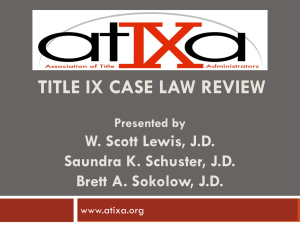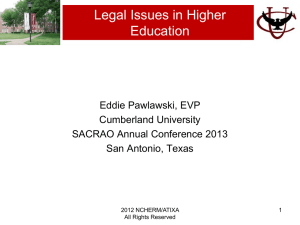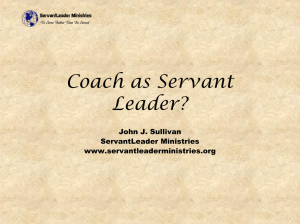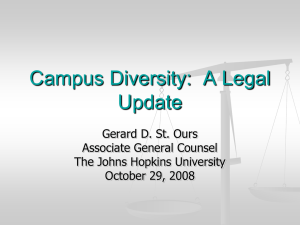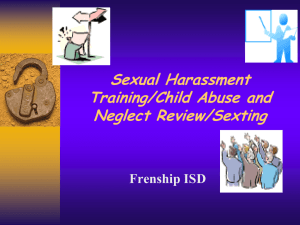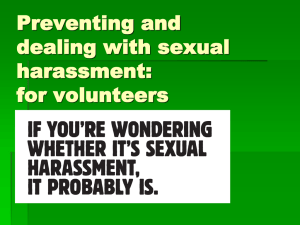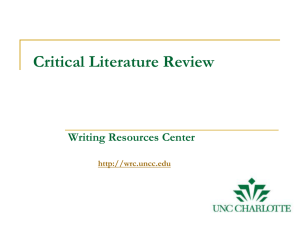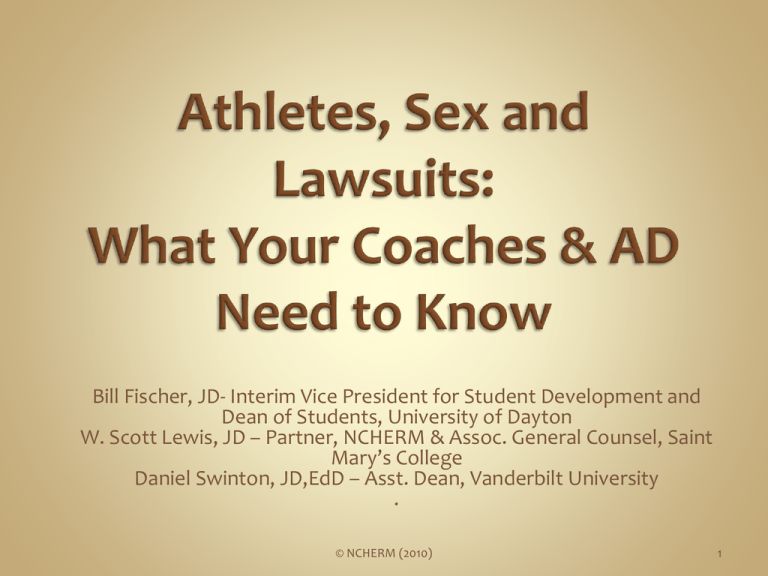
Bill Fischer, JD- Interim Vice President for Student Development and
Dean of Students, University of Dayton
W. Scott Lewis, JD – Partner, NCHERM & Assoc. General Counsel, Saint
Mary’s College
Daniel Swinton, JD,EdD – Asst. Dean, Vanderbilt University
.
© NCHERM (2010)
1
Do you know what to do (or what happens) if a
trainer, assistant coach, or any employee becomes
aware of an alleged act of sexual misconduct
involving an athlete (from assault to harassment)?
Do your staff members know?
Must you tell your supervisor? The police?
What if the victim has requested
confidentiality? What if you don’t believe her, or
believe one of your athletes is being unfairly targeted
by an accusation?
© NCHERM (2010)
2
Are you or any of your staff aware of
activities – whether during recruitment or
after signing/enrolling - that may constitute a
violation of Title VII, IX, or your colleges’ code
of conduct?
If so, what is your liability in that situation for
the knowledge you have, and what do you
need to do with what you know?
© NCHERM (2010)
3
If a student-athlete begins to show signs of low
level mental health distress – depression,
eating disorder, alcohol/substance abuse, etc. –
what are your protocols and what is your
potential liability if you fail to act?
© NCHERM (2010)
4
© NCHERM (2010)
5
Prohibits discrimination on the basis of
race, color, and national origin in
programs and activities receiving federal
financial assistance
The broad base under which the
following really take hold:
© NCHERM (2010)
6
Civil Rights Act of 1964: Title VII codified at:
42 U.S.C. §§ 2000e – 20000e-17 (2000).
Prevents discrimination in employment situations
(includes hiring, promotion, and opportunities)
based on race, color, national origin, and religion.
Also includes discrimination based on one’s
association with another based on race, color,
national origin and religion (see Iona, 2008).
Enforced in Courts and by EEOC
© NCHERM (2010)
7
Title IX of the Education Amendments of 1972
Prohibits discrimination on the basis of sex in
education programs and activities receiving
Federal financial assistance.
Discrimination can equal sexual harassment
Enforced by the OCR and the Courts
Suits brought against the institution (versus
the individual)
© NCHERM (2010)
8
The conduct must be so severe, pervasive and
objectionably offensive such that it undermines the
victim’s educational experience and denies equal
access to an institution’s resources and
opportunities
Additionally, for the institution to be liable for such
conduct, there must be:
actual notice and
a deliberately indifferent response, and
The institution must have had control over the
harasser and control over the context of the
harassment
© NCHERM (2010)
9
Every person who, under color of any statute,
ordinance, regulation, custom, or usage, of any
State or Territory or the District of Columbia,
subjects, or causes to be subjected, any citizen
of the United States or other person within the
jurisdiction thereof to the deprivation of any
rights, privileges, or immunities secured by the
Constitution and laws, shall be liable to the
party injured in an action at law, suit in equity,
or other proper proceeding for redress…
© NCHERM (2010)
10
Standard for person (and institutions)
Acted under “color of state law”
Deprived the person (Plaintiff) of rights guaranteed under
Federal Law (see Title VI, VII, IX)
Provides for actual, compensatory and
punitive damages under tort law as well as
attorney’s fees
Standard for response is lower than Title IX
© NCHERM (2010)
11
© NCHERM (2010)
12
© NCHERM (2010)
13
Jackson v. Birmingham Bd. of Ed., 544 U.S. 167 (2005)
Lisa Simpson; Anne Gilmore v. University of Colorado Boulder,
et al., (No. 06-1184, No. 07-1182; 2007U.S. App. LEXIS 21478)
U.S. Ct. of Appeals, 10th Cir., September 6, 2007
Tiffany Williams v. Board of Regents of University of Georgia,
(2006 U.S. App, LEXIS 5895) U.S. Ct. of Appeals, 11th Circuit,
March 9, 2006
Melissa Jennings v. University of N. Carolina, Chapel Hill,
(2006 U.S. App. LEXIS 8869) U.S. Ct. of Appeals, 4th Circuit,
April 11, 2006
Fitzgerald ,et al., v. Barnstable School Committee et al., 129
U.S. 788 (January 21, 2009)
© NCHERM (2010)
14
K-12 Case
1999 - Jackson complains about inequity in
sports programs’ funding (gender)
2000 - He begins to get negative evaluations
2001 – Dismissed as coach, retained as
teacher
He sues under Title IX’s private right of
action
© NCHERM (2010)
15
Procedure:
District Court – School prevails
11th Circuit – Upholds Dist. Ct. finding
Supreme Court – Overturns
Question: Does the private right of
action for discrimination only apply to
the original victim, or also to a party who
suffered a retaliatory action for the
original complaint?
© NCHERM (2010)
16
© NCHERM (2010)
17
The Facts
2 women (students) are raped by two recruits at
a party.
NOTE: The assaults occurred off‐campus, on
private property, and were in part committed by
non‐students. (speaking to the scope of Title IX)
The Procedure
District Court – Finds for CU on summary
judgment.
10th Circuit Court of Appeals - Overturns
© NCHERM (2010)
18
1.
2.
3.
That CU had an official policy of showing
high‐school football recruits a “good
time” on their visits to the CU campus;
That the alleged assaults were caused by
CU’s failure to provide adequate
supervision and guidance to player‐hosts
chosen to show the football recruits a
“good time”; and
That the likelihood of such misconduct
was so obvious that CU’s failure was the
result of deliberate indifference.
© NCHERM (2010)
19
The Facts
A student is raped by two students.
The act is arranged by the studentathlete she engaged in consensual sex
with.
The conduct process hearing occurs 1
year later with findings of not
responsible. 3 of the 4 parties are not
enrolled at that time.
© NCHERM (2010)
20
The District Court:
dismissed Williams’ Title IX and § 1983 claims,
denied her requests for declaratory and
injunctive relief, and
denied in part and granted in part her motion to
amend her complaint.
The Circuit Court of Appeals:
Reversed the district court's decisions to dismiss
Williams' Title IX claims against UGA and UGAA;
reversed the district court’s decision to deny
Williams' motion to amend her complaint;
affirmed the other holdings of the district court,
including the dismissal of the §1983 claims.
The case was then settled out of court for
an undisclosed amount.
© NCHERM (2010)
21
The central issue revolves around
Williams’ Title IX complaint against the
coach, the AD, and the president, all of
whom were central UGA employees with
authority, control and knowledge.
In particular, the court considered
whether their knowledge of Cole’s prior
acts coupled with the coaches’ failure to
inform student‐athletes about and enforce
the sexual harassment policy created
deliberate indifference under Title IX.
© NCHERM (2010)
22
Title IX – the “N” stands for
Negligence?
Is 8 months “prompt?”
How about 11?
© NCHERM (2010)
23
The Facts
A female soccer player (and two other
players) are sexually harassed (primarily
verbally) by their head coach
She reports the event to counsel and is told
to “work it out” with the coach on her own
She and her family tell the Chancellor’s
Assistant and the AD.
She is dismissed from the team.
© NCHERM (2010)
24
The district court:
dismissed Jennings Title IX and § 1983 claims,
Two other P’s settle: one for undisclosed 6
figures and the other for $70,000,
The circuit court of appeals:
Upholds the dismissal
En Banc
Overturns the Ct. of Appeals. Rules for Plaintiff
for $375K, fees, a required annual review of
policy and annual training for the coach.
© NCHERM (2010)
25
1.
2.
3.
4.
It examined the power-relationship
between coach and player
It determined the speech was not
protected
It determined that the “locker room
banter” was severe and pervasive
The “deliberate indifference” of the
response (and other failings)
© NCHERM (2010)
26
The Facts
A kindergartner is harassed by a third
grader on the bus
The reports are investigated by the
Principal and reported to the
superintendent.
No finding occurs
© NCHERM (2010)
27
The District Court:
rejected the §1983 claim, holding that Title IX
provided the only remedy.
ruled against the plaintiff on the Title IX claim
The Circuit Court of Appeals:
Affirms
The Supreme Court
Rules that violations of Title IX can give rise
to suits against individuals via §1983.
Remands the §1983 claims for
reconsideration
© NCHERM (2010)
28
Redefines a threshold for the
Title IX requirement to:
Bring an end to the discriminatory
conduct;
Take steps reasonably calculated to
prevent the future reoccurrence of the
discriminatory conduct;
Restore the victim as best you can to his
or her pre‐deprivation status.
© NCHERM (2010)
29
In light of the direction of the 3
previous decisions, forces
reconsideration of athletic department
practices, policies and procedures. In
particular:
Recruiting
Special Admissions
Hiring of Assistants
Training
© NCHERM (2010)
30
31
An assistant coach (part time employee)
tells you (the head coach), that he was
just approached by a student who says
that a member of your team, who she
used to date, sexually assaulted her last
weekend at a “team party.”
© NCHERM (2010)
32
A student athletic trainer (hourly paid position)
tells you – the Head Trainer – that she has
noticed that a member of the women’s track
team is losing weight at a disturbing pace. She
just learned about the signs of this in a class
she is in, and is sure that the athlete has an
eating disorder.
What should be your next step?
© NCHERM (2010)
33
A student comes to you – the athletic department
student/academic affairs coordinator – and tells you
that her head coach has been making sexually explicit
remarks about her and the rest of the team in the
weight room and at practice. While the rest of the
team accepts this as status quo, she feels
uncomfortable to the point of “calling in sick” to
practices.
What should be your next step?
© NCHERM (2010)
34
If so, by who?
How often?
© NCHERM (2010)
35
The College’s Sexual Harassment
Policy for student-student
harassment
The College’s Sexual Harassment
Policy for staff-student harassment
The Student Code of Conduct’s
Sexual Assault Policy
© NCHERM (2010)
36
The Departmental/College
expectation for reporting incidents
of sexual assault and harassment
Who to tell
How to tell
When to tell
Confidentiality
© NCHERM (2010)
37
The College’s resources for sexual
assault/harassment victims
including:
Law Enforcement,
Student Conduct Office,
EOP/EEOC officers,
Victims’ Services/Advocates,
Counseling Services
© NCHERM (2010)
38
The College’s Behavioral Intervention
Team reporting mechanism
How to identify early warning
behaviors for signs of mental health
issues
Their behavioral expectations, including
consequences of violations
© NCHERM (2010)
39
© NCHERM (2010)
40

